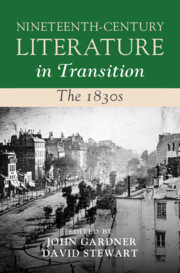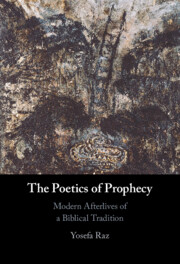231 results
5 - Romanticism, Sensibility, and Settler Women Poets
- from Part II - Networks
-
-
- Book:
- The Cambridge Companion to Australian Poetry
- Print publication:
- 13 June 2024, pp 89-100
-
- Chapter
- Export citation
Chapter 2 - Pythagoreans; or, Vegetarians before ‘Vegetarianism’
-
- Book:
- Vegetarianism and Veganism in Literature from the Ancients to the Twenty-First Century
- Published online:
- 30 May 2024
- Print publication:
- 06 June 2024, pp 20-63
-
- Chapter
- Export citation
Chapter 10 - Jorrocks’s Canon
-
-
- Book:
- Nineteenth-Century Literature in Transition: The 1830s
- Published online:
- 30 May 2024
- Print publication:
- 06 June 2024, pp 218-240
-
- Chapter
- Export citation

Nineteenth-Century Literature in Transition: The 1830s
-
- Published online:
- 30 May 2024
- Print publication:
- 06 June 2024
Chapter 14 - Romanticism
- from Part II - Literature
-
-
- Book:
- Goethe in Context
- Published online:
- 16 May 2024
- Print publication:
- 23 May 2024, pp 130-138
-
- Chapter
- Export citation
Chapter 8 - Poetry
- from Part II - Literature
-
-
- Book:
- Goethe in Context
- Published online:
- 16 May 2024
- Print publication:
- 23 May 2024, pp 77-85
-
- Chapter
- Export citation
Chapter 3 - 1837: The Foundation of a National Literature
- from Part I - Literary Dates
-
-
- Book:
- A History of Argentine Literature
- Published online:
- 09 May 2024
- Print publication:
- 16 May 2024, pp 39-51
-
- Chapter
- Export citation
Chapter 21 - Sarmiento: Politics, Culture, and Spectacle
- from Part III - Literary Names
-
-
- Book:
- A History of Argentine Literature
- Published online:
- 09 May 2024
- Print publication:
- 16 May 2024, pp 327-337
-
- Chapter
- Export citation
Chapter 8 - Romanticism
- from Part II - Inspiration and Expression
-
-
- Book:
- Vaughan Williams in Context
- Published online:
- 28 March 2024
- Print publication:
- 04 April 2024, pp 70-77
-
- Chapter
- Export citation
Chapter 12 - Sublime Puppets versus Uncanny Automata
- from Part IV - Interactions
-
-
- Book:
- Victorian Automata
- Published online:
- 15 March 2024
- Print publication:
- 28 March 2024, pp 255-271
-
- Chapter
- Export citation
Chapter 4 - We, the Romantics
-
-
- Book:
- A History of Mexican Poetry
- Published online:
- 21 March 2024
- Print publication:
- 21 March 2024, pp 78-95
-
- Chapter
- Export citation
12 - Educating the Imagination/Defending Shelley Defending
-
-
- Book:
- Percy Shelley for Our Times
- Published online:
- 07 March 2024
- Print publication:
- 14 March 2024, pp 260-275
-
- Chapter
- Export citation
The Metaphysics of Meaning: Aquinas and the Meaning of Life
-
- Journal:
- New Blackfriars ,
- Published online by Cambridge University Press:
- 01 March 2024, pp. 1-15
-
- Article
-
- You have access
- Open access
- HTML
- Export citation
Chapter 8 - Physician-Poets and Vitalist Theories of Life
- from Part II - Developments: Forms
-
-
- Book:
- Literature and Medicine
- Published online:
- 17 January 2024
- Print publication:
- 18 January 2024, pp 137-151
-
- Chapter
- Export citation

The Poetics of Prophecy
- Modern Afterlives of a Biblical Tradition
-
- Published online:
- 14 December 2023
- Print publication:
- 21 December 2023
2 - Literary and Musical Romanticism
-
- Book:
- Berlioz: <i>Symphonie Fantastique</i>
- Published online:
- 30 November 2023
- Print publication:
- 30 November 2023, pp 14-33
-
- Chapter
- Export citation
1 - Prelude
-
- Book:
- Schoenberg: ‘Night Music' – <i>Verklärte Nacht and Erwartung</i>
- Published online:
- 30 November 2023
- Print publication:
- 30 November 2023, pp 1-17
-
- Chapter
- Export citation
Conclusion
-
- Book:
- Faulkner's Cartographies of Consciousness
- Published online:
- 02 November 2023
- Print publication:
- 16 November 2023, pp 212-217
-
- Chapter
- Export citation
Chapter 5 - Heroism and History
-
-
- Book:
- The Cambridge Companion to Byron
- Published online:
- 02 November 2023
- Print publication:
- 16 November 2023, pp 69-90
-
- Chapter
- Export citation
4 - The Habsburg Monarchy
- from Part I - Imperial and Postcolonial Settings
-
-
- Book:
- The Cambridge History of Nationhood and Nationalism
- Published online:
- 08 November 2023
- Print publication:
- 09 November 2023, pp 64-87
-
- Chapter
- Export citation



